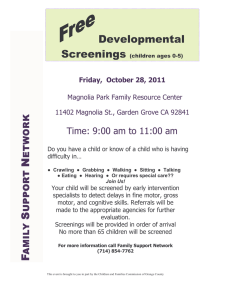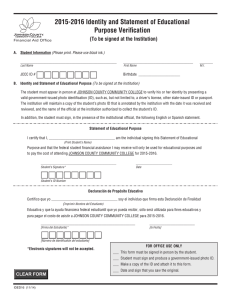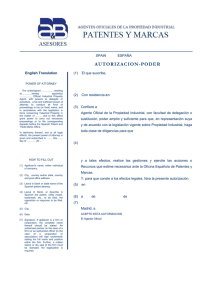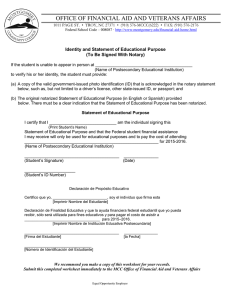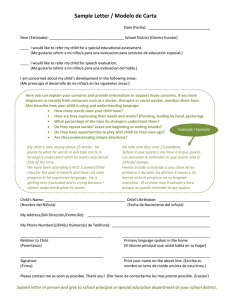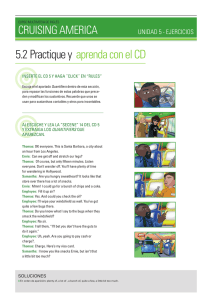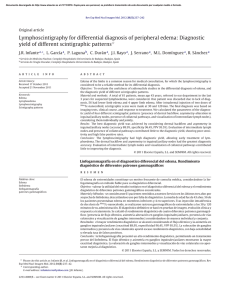PE1967S Lymphedema Program - Spanish
Anuncio
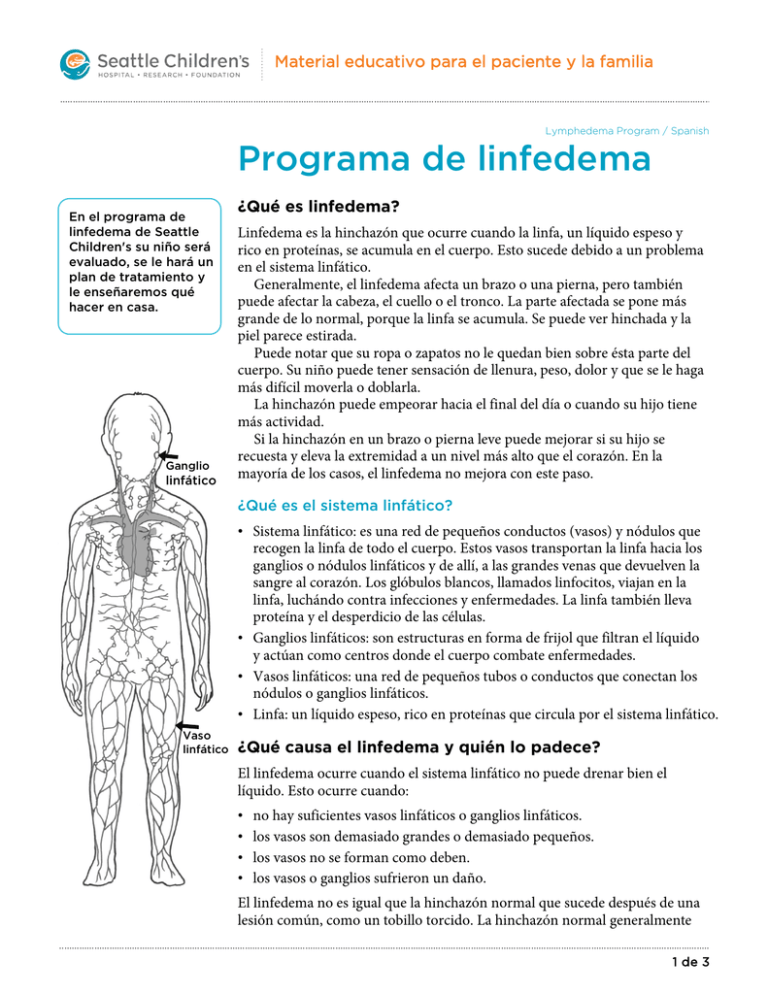
Material educativo para el paciente y la familia Lymphedema Program / Spanish Programa de linfedema En el programa de linfedema de Seattle Children's su niño será evaluado, se le hará un plan de tratamiento y le enseñaremos qué hacer en casa. Ganglio linfático ¿Qué es linfedema? Linfedema es la hinchazón que ocurre cuando la linfa, un líquido espeso y rico en proteínas, se acumula en el cuerpo. Esto sucede debido a un problema en el sistema linfático. Generalmente, el linfedema afecta un brazo o una pierna, pero también puede afectar la cabeza, el cuello o el tronco. La parte afectada se pone más grande de lo normal, porque la linfa se acumula. Se puede ver hinchada y la piel parece estirada. Puede notar que su ropa o zapatos no le quedan bien sobre ésta parte del cuerpo. Su niño puede tener sensación de llenura, peso, dolor y que se le haga más difícil moverla o doblarla. La hinchazón puede empeorar hacia el final del día o cuando su hijo tiene más actividad. Si la hinchazón en un brazo o pierna leve puede mejorar si su hijo se recuesta y eleva la extremidad a un nivel más alto que el corazón. En la mayoría de los casos, el linfedema no mejora con este paso. ¿Qué es el sistema linfático? • Sistema linfático: es una red de pequeños conductos (vasos) y nódulos que recogen la linfa de todo el cuerpo. Estos vasos transportan la linfa hacia los ganglios o nódulos linfáticos y de allí, a las grandes venas que devuelven la sangre al corazón. Los glóbulos blancos, llamados linfocitos, viajan en la linfa, luchándo contra infecciones y enfermedades. La linfa también lleva proteína y el desperdicio de las células. • Ganglios linfáticos: son estructuras en forma de frijol que filtran el líquido y actúan como centros donde el cuerpo combate enfermedades. • Vasos linfáticos: una red de pequeños tubos o conductos que conectan los nódulos o ganglios linfáticos. • Linfa: un líquido espeso, rico en proteínas que circula por el sistema linfático. Vaso linfático ¿Qué causa el linfedema y quién lo padece? El linfedema ocurre cuando el sistema linfático no puede drenar bien el líquido. Esto ocurre cuando: • • • • no hay suficientes vasos linfáticos o ganglios linfáticos. los vasos son demasiado grandes o demasiado pequeños. los vasos no se forman como deben. los vasos o ganglios sufrieron un daño. El linfedema no es igual que la hinchazón normal que sucede después de una lesión común, como un tobillo torcido. La hinchazón normal generalmente 1 de 3 Programa de linfedema desaparece después de pocos días o semanas, pero el linfedema no mejora por su cuenta. Linfedema primario El linfedema primario es cuando el niño nace con menos vasos o ganglios linfáticos. También puede ser que los vasos o los ganglios no se formen normalmente y no recogen o filtren el líquido linfático como deben. Los síntomas pueden estar presentes al nacer o aparecer a medida que crece. A veces los síntomas aparecen durante una etapa de crecimiento mayor en el niño o adolescente. Linfedema secundario En el linfedema secundario su hijo nace con ganglios y vasos normales, pero han sido dañados o eliminados y ahora el líquido linfático no fluye como debe. A veces ocurre a causa del tratamiento para el cáncer, de una lesión o infección. ¿El linfedema puede mejorar o empeorar? El linfedema es una condición duradera (crónica) que no se quita y, si no se trata, empeora. Cuando se colecta, la linfa atrae más líquido a esa área. El linfedema también puede causar endurecimiento de la piel y de otros tejidos (fibrosis). Esto dificulta el drenaje del líquido aún más. La hinchazón y la fibrosis bloquean el oxígeno y los nutrientes al área. Esto puede impedir que las heridas cicatricen bien y aumente el riesgo de infección en la piel (celulitis) y en los vasos linfáticos (linfangitis). ¿Cómo se trata el linfedema? El programa de linfedema en Seattle Children's lo compone un grupo de doctores, enfermeras, ergoterapeutas y fisioterapeutas certificados con capacitación adicional en el manejo de linfedemas. Si a su niño le refieren a este programa, le evaluarán y desarrollarán un plan de tratamiento especial para él, usándo la terapia descongestiva completa (TDC). La terapia descongestiva completa (TDC) se compone de 4 partes: • Cuidado de la piel: con pasos sencillos se trata de mantener la piel saludable para prevenir infecciones o descubrir y tratarlas a tiempo. El terapeuta de su hijo les enseñará a mantener la piel limpia, a cuidar de heridas menores y a reconocer los signos de infección. • Drenaje linfático manual: este método especial de masaje ligero puede facilitar el flujo de la linfa hacia y a través de los vasos linfáticos. El terapeuta de su niño utilizará este método para drenar el área hinchada. Usted y su niño también aprenderán para hacerlo en casa. 2 de 3 Programa de linfedema Para más información • Anomalías Vasculares 206-987-4606 • Hable con el proveedor de atención médica de su hijo. • www.seattlechildrens.org • Terapia de compresión: envolver la extremidad hinchada con vendas estiradas a ciertos intervalos puede hacer que la linfa fluya hacia el tronco. El terapeuta de su hijo lo hará y también les enseñará cómo hacerlo. Una vez que la hinchazón baje, el terapeuta le tomará medidas a su niño para que le hagan prendas de compresión a la medida. Su niño usará estas mangas o medias especiales para mantener la presión en el área y evitar que la linfa se vuelva a acumular. • Ejercicio: ciertas acciones que mueven los músculos y la piel pueden estimular el sistema linfático. El terapeuta hará un programa sencillo, adaptado a su hijo, para que haga los movimientos durante todo el día en el hogar. Fases del tratamiento Servicio gratuito de interpretación • En el hospital, solicítelo a la enfermera de su hijo. • Fuera del hospital, llame a la línea gratuita de Interpretación 1-866583-1527. Dígale al intérprete el nombre de la persona o la extensión que necesita. Una parte importante de este tratamiento es el enfoque en dar información y enseñanza para que puedan completar toda la terapia en casa. Para manejar el linfedema de su niño, los miembros de la familia necesitarán darle terapia continua y constante. Las primeras 2 fases del tratamiento se hacen en el hospital Seattle Children’s. FASE 1 En la fase 1 su niño vendrá 3 a 5 veces por semana, por sesiones de 1 a 2 horas para el tratamiento y la enseñanza. La duración de esta fase puede ser de 2 a 4 semanas, dependiendo de la severidad del linfedema de su niño. La meta de esta fase es reducir el linfedema y entrenarles para que puedan terminar la terapia decongestiva completa con su niño en casa. Al final de esta fase, probablemente tomarán medidas a su niño para encargar la prenda de compresión a su medida. FASE 2 La fase 2 del tratamiento comenzará cuando el linfedema haya disminuido y sienta que ya puede manejar el linfedema de su niño en casa. Durante esta fase se le probará la prenda de compresión y tendrá citas 1 vez por semana durante 1 mes. Después lo verán una vez al mes, según sea necesario. La prenda de compresión de su niño se debe cambiar por una nueva cada 4 a 6 meses. Para saber más acerca de la compresión, lea nuestro folleto “Prendas de compresión” www.seattlechildrens.org/pdf/PE1840.pdf (en inglés). Seattle Children's ofrece servicio de interpretación gratuito para los pacientes, sus familiares y representantes legales sordos, con problemas de audición o con inglés limitado. Seattle Children's tendrá disponible esta información en formatos alternativos bajo solicitud. Llame al Centro de Recursos para Familias al 206-987-2201. Este volante ha sido revisado por el personal clínico de Seattle Children's. Sin embargo, como las necesidades de su niño son únicas, antes de actuar o depender de esta información, por favor consulte con el médico de su hijo. © 2014 Seattle Children’s, Seattle, Washington. Derechos reservados. Anomalías vasculares 10/14 Tr(lv/mhg) PE1967S 3 de 3 Patient and Family Education Lymphedema Program In the Lymphedema Program at Seattle Children’s, your child will be evaluated and a treatment plan will be developed to address the lymphedema and to teach you how to manage it at home. Lymph nodes What is lymphedema? Lymphedema is swelling that happens when thick, protein-rich fluid called lymph builds up in the body. This happens because of a problem in the lymph system. Usually lymphedema affects an arm or leg, but it can also affect the head, neck and trunk. The area gets larger than normal because of the lymph fluid building up. It may look puffy, and the skin may appear tight. You may notice that your child’s clothes or shoes don’t fit well over the swollen part. The area may feel full, heavy or achy to your child. The body part might become harder to move or bend. Swelling may be worse at the end of the day or after your child has been more active. Minor swelling in an arm or leg may improve if your child lies down and raises the limb higher than the heart. In most cases, lymphedema will not get better with this step. What is the lymph system? • Lymph system: A network of small tubes (vessles) and nodes that pick up lymph fluid from all around the body. These vessels channel the lymph through the lymph nodes and into the large veins that return blood to the heart.White blood cells called lymphocytes travel in the lymph, fighting infection and disease. Lymph also carries protien and waste from cells. • Lymph nodes: Bean-like structures that that filter fluid and serve as centers where the body fights disease. • Lymph vessels: A network of small tubes that connect the lymph nodes. • Lymph: A thick, protien-rich fluid that runs though the lymph system. What causes lymphedema and who gets it? Lymphedema occurs when the lymph system can’t drain lymph fluid well. Reasons why the lymph system can’t drain well: Lymph vessels • • • • There aren’t enough lymph vessels or lymph nodes The vessels are too big or too small The vessels didn’t form as they should The vessels or nodes were damaged Lymphedema is not the same as the normal swelling that happens after a common injury, like a sprained ankle. Normal swelling usually goes away for good after a few days or weeks, but lymphedema does not get better on its own. 1 of 3 Lymphedema Program Primary lymphedema In primary lymphedema, your child is born without some lymph vessels or nodes. It is also possible the vessels or nodes didn’t form normally and don’t collect or filter lymph fluid the way they should. Symptoms may be present at birth or may not appear until your child is older. Sometimes symptoms start during a growth spurt in an older child or teen. Secondary lymphedema In secondary lymphedema, your child was born with healthy lymph nodes and vessels, but now the lymph fluid doesn’t flow the way it should because they were damaged or removed. Causes may include cancer treatment, injury or infection. Will lymphedema get better or worse? Lymphedema is a long-lasting (chronic) condition that won’t go away. It gets worse if it’s not treated. Once lymph collects, it pulls more fluid to that area. Lymphedema can also lead to hardening of the skin and tissue (fibrosis), which makes it harder for lymph fluid to drain. Swelling and fibrosis keep oxygen and nutrients from getting into the area. This can keep wounds from healing well, and it can increase the risk for infection in the skin (cellulitis) and lymph vessels (lymphangitis). How is lymphedema treated? The lymphedema program at Seattle Children’s Hospital includes a team of doctors, nurses, and certified lymphedema therapists, occupational therapists and physical therapists with extra training to manage lymphedema. If your child is referred to the program, your child will be evaluated and a treatment plan will be developed just for them using Complete Decongestive Therapy (CDT). There are 4 parts to Complete Decongestive Therapy (CDT): • Skin care: Simple steps can help keep your child’s skin healthy and prevent infections or give you a chance to notice and treat any infection early. Your child’s therapist will teach you and your child how to keep the skin clean, how to take care of minor wounds and which signs might mean the skin is infected. • Manual lymph drainage: This special method of gentle massage can improve the flow of lymph into and through the lymph vessels. Your child’s therapist will use this method to drain a swollen area. We’ll also teach you and your child how to do this at home. • Compression therapy: Wrapping a swollen limb with short stretch bandages can get lymph to flow out of the limb into the trunk. Your child’s therapist will do this and will also teach you and your child to use wrapping at home. Once the swelling goes down, the therapist will measure your 2 of 3 Lymphedema Program To Learn More • Vascular Anomalies 206-987-4606 • Ask your child’s healthcare provider • www.seattlechildrens.org Free Interpreter Services • In the hospital, ask your child’s nurse. • From outside the hospital, call the toll-free Family Interpreting Line 1-866-583-1527. Tell the interpreter the name or extension you need. child for custom compression garments. Your child wears these special sleeves or stockings to keep pressure on the area and prevent lymph from building up again. • Exercise: Certain actions that move the muscles and skin can stimulate the lymph system. Your child’s therapist will create a simple home program that’s right for your child to promote movement throughout the day. Treatment phases An important part of this treatment also focuses on giving you and your child information and training of how to complete this therapy when you are at home. In order to manage your child’s lymphedema, family members will need to provide ongoing and consistent therapy. There are 2 phases of treatment provided at Seattle Children’s Hospital. Phase 1 In phase 1, your child may be seen 3 to 5 times a week for 1 to 2 hour sessions for treatment and education. This phase depends on the severity of your child’s lymphedema and may last 2 to 4 weeks. The goal of this phase is to decrease the lymphedema and train you to complete a complete decongestive therapy with your child at home. Your child will likely be measured for a custom compression garment at the end of this phase. Phase 2 Once the lymphedema has decreased and you feel comfortable with how to manage your child’s lymphedema at home, your child will be in phase 2 of treatment. During phase 2, your child will be fitted for their custom compression garment and will be seen about 1 time a week for 1 month. Then 1 time per month as needed. Your child’s compression garment will need to be replaced every 4 to 6 months. To learn more, read our handout “Compression Garments” www.seattlechildrens.org/pdf/PE1840.pdf. Seattle Children’s offers interpreter services for Deaf, hard of hearing or non-English speaking patients, family members and legal representatives free of charge. Seattle Children’s will make this information available in alternate formats upon request. Call the Family Resource Center at 206-987-2201. This handout has been reviewed by clinical staff at Seattle Children’s. However, your child’s needs are unique. Before you act or rely upon this information, please talk with your child’s healthcare provider. © 2014 Seattle Children’s, Seattle, Washington. All rights reserved. Vascular Anomalies 10/14 PE1967 3 of 3

